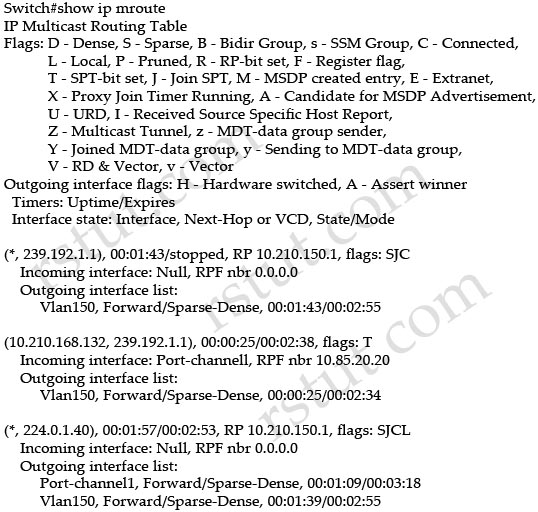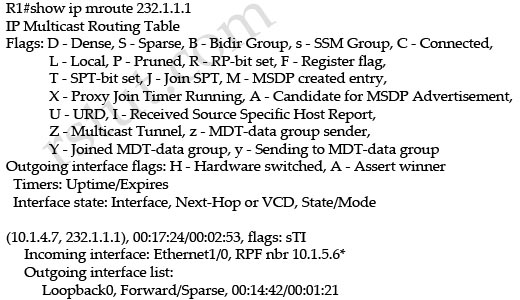Multicast Questions
Question 1
Refer to the exhibit.
| R4 interface FastEthernet0/1 ip address 192.168.2.1 255.255.255.0 ip pim sparse-dense-mode duplex auto speed auto standby 1 ip 192.168.2.4 standby 1 priority 150 standby 1 preempt R5 interface FastEthernet0/1 ip address 192.168.2.2 255.255.255.0 ip pim sparse-dense-mode duplex auto speed auto standby 1 ip 192.168.2.4 |
The interface FastEthernet0/1 of both routers R4 and R5 is connected to the same Ethernet segment with a multicast receiver. Which two statements are true? (Choose two)
A. Multicast traffic that is destined to a receiver with IP address 192.168.2.6 will flow through router R4.
B. Both routers R4 and R5 will send PIM join messages to the RP.
C. Only router R5 will send a multicast join message to the RP.
D. Multicast traffic that is destined to a receiver with IP address 192.168.2.6 will flow through router R5.
Answer: C D
Question 2
Which technology can be used to prevent flooding of IPv6 multicast traffic on a switch?
A. IGMP snooping
B. IGMP filtering
C. MLD snooping
D. MLD filtering
Answer: C
Question 3
Which two statements are true about IPv6 multicast? (Choose two)
A. Receivers interested in IPv6 multicast traffic use IGMPv6 to signal their interest in the IPv6 multicast group.
B. The PIM router with the lowest IPv6 address becomes the DR for the LAN.
C. An IPv6 multicast address is an IPv6 address that has a prefix of FF00::/8.
D. The IPv6 all-routers multicast group is FF02:0:0:0:0:0:0:2.
Answer: C D
Question 4
Refer to the exhibit.

Which two statements about the device that generated the output are true? (Choose two)
A. The SPT-bit is set.
B. The sparse-mode flag is set.
C. The RP-bit is set.
D. The source-specific host report was received.
Answer: A D
Question 5
Refer to the exhibit.

Which three statements about the output are true? (Choose three)
A. This switch is currently receiving a multicast data stream that is being forwarded out VLAN 150.
B. A multicast receiver has requested to join one or more of the multicast groups.
C. Group 224.0.1.40 is a reserved address, and it should not be used for multicast user data transfer.
D. One or more multicast groups are operating in PIM dense mode.
E. One or more of the multicast data streams will be forwarded out to neighbor 10.85.20.20.
F. Group 239.192.1.1 is a reserved address, and it should not be used for multicast user data transfer.
Answer: A B C
Question 6
Which statement is true about IGMP?
A. Multicast sources send IGMP messages to their first-hop router, which then generates a PIM join message that is then sent to the RP.
B. Multicast receivers send IGMP messages to their first-hop router, which then forwards the IGMP messages to the RP.
C. IGMP messages are encapsulated in PIM register messages and sent to the RP.
D. Multicast receivers send IGMP messages to signal their interest to receive traffic for specific multicast groups.
Answer: D
Question 7
Where is multicast traffic sent, when it is originated from a spoke site in a DMVPN phase 2 cloud?
A. spoke-spoke
B. nowhere, because multicast does not work over DMVPN
C. spoke-spoke and spoke-hub
D. spoke-hub
Answer: D
Question 8
Refer to the exhibit.

What is the meaning of the asterisk (*) in the output?
A. PIM neighbor 10.1.5.6 is the RPF neighbor for the group 232.1.1.1 for the shared tree.
B. PIM neighbor 10.1.5.6 is the one that is seen as the RPF neighbor when performing the command show ip rpf 10.1.4.7.
C. PIM neighbor 10.1.5.6 is the winner of an assert mechanism.
D. The RPF neighbor 10.1.5.6 is invalid.
Answer: C

Can anyone explain Q1?
Q1, I think the correct response are A and B.
I’d say the same since R4 is the active unit. I’ve tried to simulate this in GNS3 but I don’t know how to emulate multicast traffic.
I think also A and B, have you test the Question in GNS3
Answer ir correct. DR is elected by Higher IP address or priority. R5 has 192.168.2.2 and R4 has 192.168.2.1. R5 is the DR which send all paguets to RP.
Q8, Why is answerB incorrect?
I will have to test this. How do you know it is using OSPF Cesar? I think it should be A and B because of the priority.
For Q1, the answer is A and C.
HSRP is unicast traffic only.
Multicast RP election : 1. Highest priority
2. Highest interface
It’s doenst matter on multicast RP , that’s why the RP is R5.
So definatly B is false.
R4 and R5 configured as HSRP. Lets assume there is R3 too. So traffic multicast will going from R6 to R3 through HSRP router which is R4 and R5. R6 will going through R4 because R4 is active and virtual interface tracking interface R4 192.168.2.4.
This is some text that I took from a forum:
The Designated Forwarder is Pim Bidirectional Concept , the role of DF is primarily sends Multicast received from the Source towards the RP not encapsulated because its rooted at the Shared tree. the Pim DF is a router that has least metric towards the RP.
Be notice that in Pim Bidirectional, the DR is also DF , there is no specific DR in pim bidirectional.
In Pim Sparse mode, the RP receives Encapsulated Multicast from the Source which is unicasted through Pim registration message, this process goes on till a register stop message received from the RP.
a last point here is: changing the DR-Priority shouldn’t change the forwarder role, it should change the DR role, because a DR on a segment is that a router with a highest priority or in case of a tie, its the router with the highest IP address.
But, the DF, is always the router with lowest metric (cost) towards the RP and if there is a tie, it would be the router with the highest IP address on the Segment.
The difference between DR and DF can simply be defined as follows:
The DF: is a router forwards multicast traffic upstream on the shared tree.
The DR: is a router forwards the multicast traffic downstream on the shared tree
I hope this answers your question,
Regards,
@wannabe
DR sends traffic upstream from the sender’s segment, not downstream
Please explain the Q5!!!!!!!!!
The Multicast router joins the group 224.0.1.40 to listen to the Auto-RP discovery messages – this is the default behavior for Cisco routers and you cannot change it.
Q#2
In IPv4, Layer 2 switches can use IGMP snooping to limit the flooding of multicast traffic by dynamically configuring Layer 2 interfaces so that multicast traffic is forwarded to only those interfaces associated with IP multicast address. In IPv6, MLD snooping performs a similar function. With MLD snooping, IPv6 multicast data is selectively forwarded to a list of ports that want to receive the data, instead of being flooded to all ports in a VLAN. This list is constructed by snooping IPv6 multicast control packets.
MLD is a protocol used by IPv6 multicast routers to discover the presence of multicast listeners (nodes configured to receive IPv6 multicast packets) on its directly attached links and to discover which multicast packets are of interest to neighboring nodes. MLD is derived from IGMP; MLD version 1 (MLDv1) is equivalent to IGMPv2, and MLD version 2 (MLDv2) is equivalent to IGMPv3. MLD is a subprotocol of Internet Control Message Protocol version 6 (ICMPv6), and MLD messages are a subset of ICMPv6 messages, identified in IPv6 packets by a preceding Next Header value of 58.
The switch can snoop on both MLDv1 and MLDv2 protocol packets and bridge IPv6 multicast data based on destination IPv6 multicast MAC addresses. The switch can be configured to perform MLD snooping and IGMP snooping simultaneously.
I’ve tested on Lab for Question 1
Source
|
R1 (RP)
|
SW01
/ \
R4 R5
\ /
SW02
|
Client
– R1 receives PIM Join from both R4 & R5
– Multicast traffic only flows through R5
Answer: B, D
Dears,
can anyone support for Q.4
Rgds